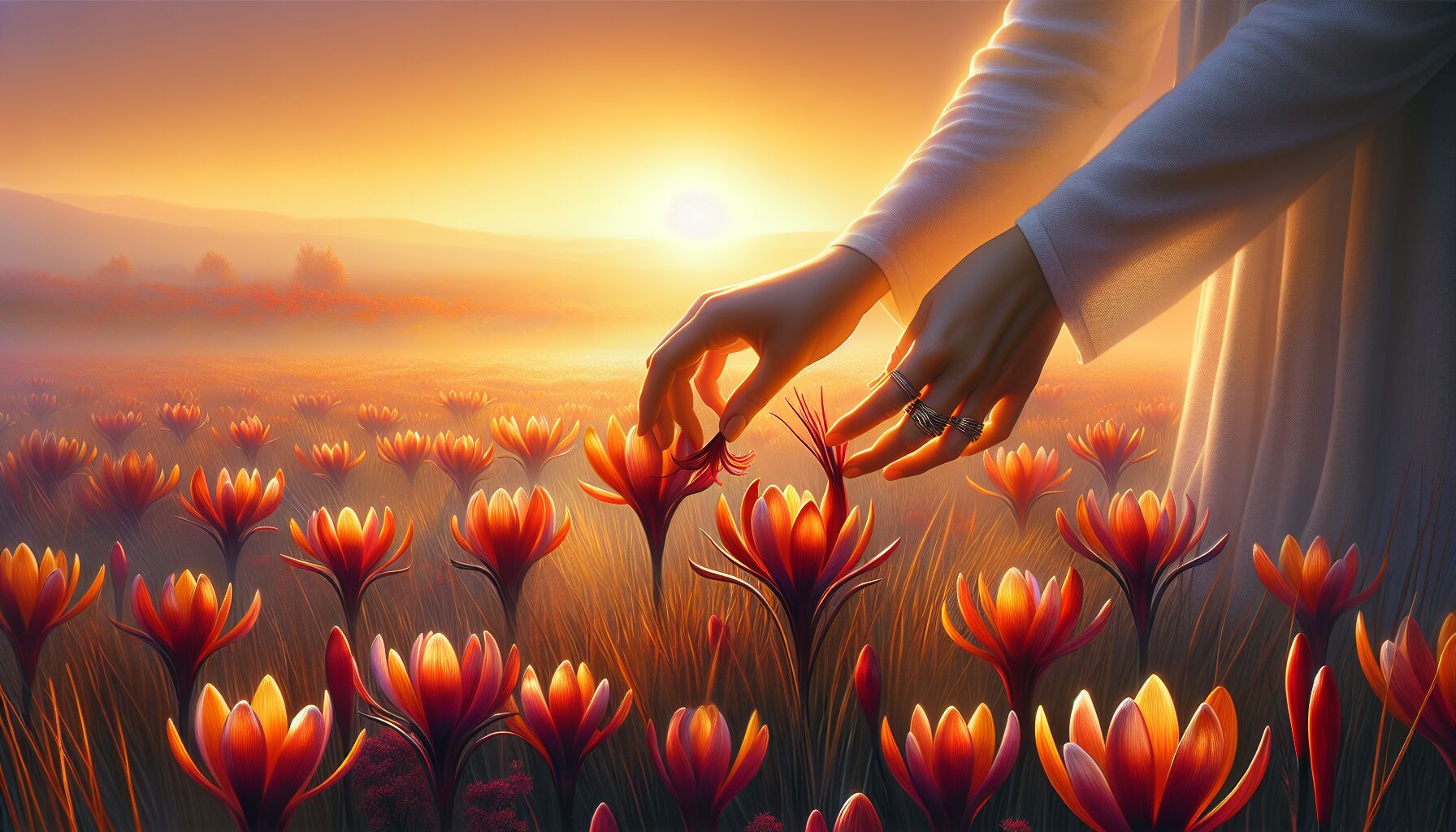 Sowing the seeds of saffron isn’t quite like planting ordinary crops. Picture this: a delicate dance of hands, tending to fields like a ritual passed down through generations. The challenges of cultivating saffron are rooted deep in both the earth and spirit. This isn’t just any crop; it’s one of the most revered ancient spices, demanding precise conditions and gentle labor.
Sowing the seeds of saffron isn’t quite like planting ordinary crops. Picture this: a delicate dance of hands, tending to fields like a ritual passed down through generations. The challenges of cultivating saffron are rooted deep in both the earth and spirit. This isn’t just any crop; it’s one of the most revered ancient spices, demanding precise conditions and gentle labor.
The saffron crocus blooms only for a brief window in autumn, requiring a soil that’s as picky as it is fertile. It’s not for those who shy away from hard work. Planting begins in summer when the corms — think of them as the plant’s power cells — are tucked into the earth with care. Their nemesis? Wet feet! They loathe water-logged soil, a surprising quirk that adds to the mystique. Isn’t it curious how a crop so intricate thrives best with just enough rainfall?
Once the blooms burst forth, the harvest begins. A labor of love, really. Each saffron flower offers up a mere trio of vivid stigmas, the golden threads that we call saffron. They’re hand-plucked at dawn, when the blooms are fresh and fragrant. With the sun still yawning, imagine farmers gathering these precious filaments — it’s like gathering sunlight spun into silk. For a single pound of saffron, around 75,000 flowers are needed. Can you picture that?
The labor intensity doesn’t end there. Processing requires meticulous care to preserve the medicinal value and vibrant color. An age-old question hangs in the air: why go through endless toil for these fragile threads? The answer lies in saffron’s alchemy. It’s not just a spice; it’s a storied treasure in realms of culinary and medicinal arts.
Interestingly, this laborious process entwines deeply with the spirituality of those who harvest. There’s a reverence in watching the cycles of nature orchestrate an ancient dance, a reminder of how humans have always been part of a greater rhythm. As William Blake once hinted, seeing a world in a grain of sand entails seeing life’s essence in each saffron thread.
In contemporary agriculture, the echoes of ancient practices linger, reminding us of the broader connection between land and life. It’s a poignant reflection on why we value certain traditions, even when modernity beckons with easier paths.
Curious about saffron’s medicinal wonders? Explore its secrets! And if you’re wondering about weather patterns that these precious blooms adore, take a look at what the experts say about climate impacts. The dance of saffron sowing and harvesting might just inspire you to see the ground beneath us as more than just soil, but the fabric of life itself.
uses of saffron in ancient cultures
Saffron was more than a splash of color on a dish; it painted the very essence of ancient cultures with its hues and unique properties. Back then, saffron wasn’t just tossed into a pot; it was cherished, often akin to the divine. In culinary arts, saffron’s allure lay in its ability to transform the mundane into the sublime. Picture a pot of rice, subtly shifting from ivory to golden under the sprinkling of saffron threads, whispering tales from kitchens of Babylon to the kitchens of Alexandria. For the ancients, cooking was often a ritual, and saffron played its part like a king among spices.
But food wasn’t its only realm. The medicinal value of saffron was revered across several civilizations, making it an esteemed member of the ancient spice cabinets. Known for its potential mood-enhancing properties, saffron was sought after for its calming effects. Ancient texts reveal that it was brewed into teas or crushed into poultices, a natural remedy for ailments from those days. Imagine seeking solace in saffron-infused drinks or using its gentle touch to steady a weary mind. Isn’t it fascinating how a single thread of saffron could tie together health and harmony?
In the realm of spirituality and rituals, saffron was no less significant. It was often used in offerings and ceremonies, believed to purify and bring peace. Its vibrant hue was emblematic of sunrise, a bridge between the earth and the divine. There’s something deeply spiritual about how ancient cultures perceived the world, viewing saffron not just as a spice, but as a sacred symbol.
As Buddha once shared, “Three things cannot be long hidden: the sun, the moon, and the truth.” For these cultures, the truth was deeply intertwined with nature’s gifts — including saffron. This perspective held true across different lands, echoing in sanctuaries where saffron’s fragrance lingered long after prayers concluded.
Even industries outside the culinary and medicinal spheres recognized saffron’s worth. Its dye was used in textiles, lending a rich golden-yellow to fabrics, which became symbols of wealth and power. Only the esteemed wore saffron robes, a visual testament to its high regard.
Connections between modern uses and ancient wisdom can still be traced. Today’s pursuits for natural remedies and vibrant culinary experiences echo out of these ancient practices. The wisdom of the past, with its emphasis on interconnectedness with nature, finds its way into current trends focusing on mindfulness and holistic living.
While saffron threads may be tiny, the stories they carry stretch across time, weaving a fascinating tapestry of culture and faith. We could ask ourselves: what other treasures lie in the spices on our shelves, waiting to tell tales of beauty and resilience? As we spice our meals, are we tasting the legacy of our ancestors? For those willing to listen, saffron still speaks volumes.
economic and trade significance
 Trade routes crisscrossing the ancient world were more than just highways for goods; they were lifelines connecting cultures, ideas, and economies. Saffron, the crowned jewel of spices, played a prominent role in this bustling tapestry. Its economics boiled down to a simple yet powerful equation: high demand and limited supply. Imagine caravans laden with this golden treasure, weaving through deserts and mountains, guarded as fiercely as one would protect gold.
Trade routes crisscrossing the ancient world were more than just highways for goods; they were lifelines connecting cultures, ideas, and economies. Saffron, the crowned jewel of spices, played a prominent role in this bustling tapestry. Its economics boiled down to a simple yet powerful equation: high demand and limited supply. Imagine caravans laden with this golden treasure, weaving through deserts and mountains, guarded as fiercely as one would protect gold.
So why did saffron command such value? Part of the allure stemmed from its scarcity — the very same threads that lent color and flavor only grew under precise conditions, making them rare. But there was more to it. Saffron’s diverse uses ranged from the culinary to the medicinal, offering a wealth of benefits that were hard to ignore. As ancient physicians and cooks swapped anecdotes of its healing properties and aromatic wonders, its reputation spread like wildfire.
Consider it a status symbol of the times. In Persia, saffron was sprinkled in royal baths, a testament to opulence and indulgence. Cleopatra, the legendary queen of Egypt, was rumored to have bathed in saffron-infused water to enhance her allure. But it wasn’t just about luxury. Several cultures knew of saffron’s medicinal value, using it as a remedy for ailments ranging from digestive issues to mood imbalance. Isn’t it remarkable how these ancient practices resonate even now, echoing in today’s world of alternative healing?
How exactly did saffron move from one corner of the earth to another? Enter the Silk Road, a network that was more than commerce; it was a crossroads of civilizations. Merchants and travelers traded not just goods but stories, philosophies, and faiths — saffron travelling as a symbol of wealth and spiritual power. The Greeks, for instance, held it in high esteem, evidenced by frescoes that depict saffron as an offering to the gods.
With such a high demand, it’s no wonder that countries like Iran, India, and Greece vied for a place in saffron’s history. They became the ancient hubs where saffron thrived, contributing to not just local economies, but also their cultural wealth. It’s fascinating how saffron, a seemingly small and delicate flower, could wield such big economic influence.
If you’re interested in exploring the modern echoes of this trade, check out resources like the National Geographic for insights into saffron’s journey through time. For those who appreciate numbers, the economic significance of saffron is detailed further in agricultural reports at the Food and Agriculture Organization.
As we cook with saffron today, infusing our dishes with its warmth, it’s worth reflecting on how this humble spice has bridged continents and cultures. Its threads don’t just season our meals; they weave history and heritage, inviting us to partake in an ancient tradition that spans the globe. What other stories lie untold in the deep, rich color of saffron? Surely, there’s no better spice to remind us that there’s more than meets the eye.
 DS Haven In Light Of Things
DS Haven In Light Of Things






